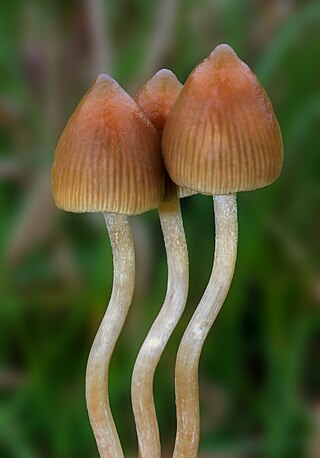
Psilocybe semilanceata, commonly known as the liberty cap, is a species of fungus which produces the psychoactive compounds psilocybin, psilocin and baeocystin. It is both one of the most widely distributed psilocybin mushrooms in nature, and one of the most potent. The mushrooms have a distinctive conical to bell-shaped cap, up to 2.5 cm (1 in) in diameter, with a small nipple-like protrusion on the top. They are yellow to brown, covered with radial grooves when moist, and fade to a lighter color as they mature. Their stipes tend to be slender and long, and the same color or slightly lighter than the cap. The gill attachment to the stipe is adnexed, and they are initially cream-colored before tinting purple to black as the spores mature. The spores are dark purplish-brown in mass, ellipsoid in shape, and measure 10.5–15 by 6.5–8.5 micrometres.

Psilocybe tampanensis is a very rare psychedelic mushroom in the family Hymenogastraceae. Originally collected in the wild in a sandy meadow near Tampa, Florida, in 1977, the fungus would not be found in Florida again until 44 years later. The original Florida specimen was cloned, and descendants remain in wide circulation. The fruit bodies (mushrooms) produced by the fungus are yellowish-brown in color with convex to conic caps up to 2.4 cm (0.9 in) in diameter atop a thin stem up to 6 cm (2.4 in) long. Psilocybe tampanensis forms psychoactive truffle-like sclerotia that are known and sold under the nickname "philosopher's stones". The fruit bodies and sclerotia are consumed by some for recreational or entheogenic purposes. In nature, sclerotia are produced by the fungus as a rare form of protection from wildfires and other natural disasters.

Panaeolus cinctulus, syn. Panaeolus subbalteatus, commonly known as the banded mottlegill, weed Panaeolus, belted panaeolus, or subbs is a very common, widely distributed psilocybin mushroom. According to American naturalist and mycologist David Arora, Panaeolus cinctulus is the most common psilocybin mushroom in California.

Panaeolus is a genus of small, black-spored, saprotrophic agarics. The word Panaeolus is Greek for "all variegated", alluding to the spotted gills of the mushrooms produced.

Panaeolus tropicalis is a species of psilocybin producing mushroom in the family Bolbitiaceae. It is also known as Copelandia tropicalis.

Panaeolus cyanescens is a mushroom in the Bolbitiaceae family. Panaeolus cyanescens is a common psychoactive mushroom and is similar to Panaeolus tropicalis.
Panaeolus africanus is a little brown mushroom that contains irregular amounts of the hallucinogens psilocybin and psilocin. It has been found in central Africa and southern Sudan.
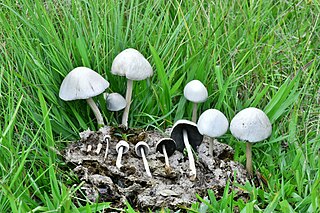
Panaeolus antillarum is a species of mushroom in the family Bolbitiaceae. It is edible but not commonly eaten. It is found from northern North America through Mexico into northern South America.

Panaeolus bisporus, also known as Copelandia bisporus is a rare and widely distributed little brown mushroom that bruises blue and contains the hallucinogen psilocybin.

Panaeolus cambodginiensis is a potent hallucinogenic mushroom that contains psilocybin and psilocin. It was described in 1979 as Copelandia cambodginiensis.
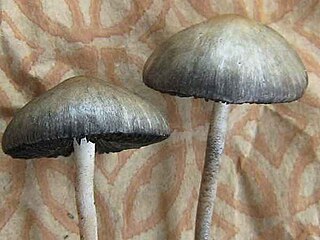
Panaeolus olivaceus is a widely distributed, seldom identified, little brown mushroom that contains the hallucinogen psilocybin; it is often mistaken for Panaeolus foenisecii and is distinguished by its black spore print and darker gill coloration when mature alongside a slightly thicker stem. It is even more easily mistaken for Panaeolus cinctulus or Panaeolus fimicola and can be distinguished from them both by its slightly roughened spores. It is also easily confused with Panaeolina castaneifolia, a species which has spores that are dark brown and significantly more roughened.
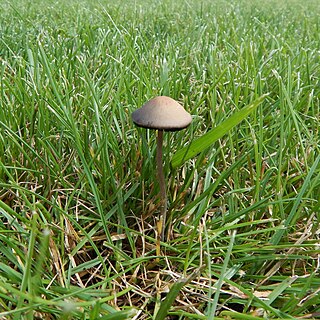
Panaeolus fimicola is a widespread but seldom identified "little brown mushroom" which sometimes contains small amounts of the hallucinogen psilocybin. Panaeolus ater is a synonym. The species is also referred to as the "turf mottlegill".

Panaeolus papilionaceus, also known as Agaricus calosus, Panaeolus campanulatus, Panaeolus retirugis, and Panaeolus sphinctrinus, and commonly known as Petticoat mottlegill, is a very common and widely distributed little brown mushroom that feeds on dung.

Panaeolus semiovatus var. semiovatus, also known as Panaeolus semiovatus and Anellaria separata, and commonly known as the shiny mottlegill, ringed panaeolus, common fungus of the feces variety, or egghead mottlegill, is a medium-sized buff-colored mushroom that grows on horse dung, and has black spores. Though nonpoisonous, it is generally regarded as inedible and possessing a rather abysmal taste, and a few people experience gastric upset after consumption.
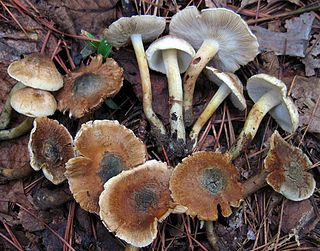
Inocybe corydalina var. corydalina, commonly known as the greenflush fibrecap, is a member of the genus Inocybe which is widely distributed in temperate forests. It is a small mycorrhizal mushroom which contains a small amount of the hallucinogen psilocybin.
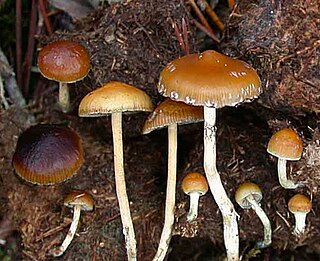
Psilocybe fimetaria is a psilocybin mushroom, having psilocybin and psilocin as main active compounds. It grows exclusively on horse and cow dung.

Panaeolina castaneifolia is a rare and widely distributed little brown mushroom.
Panaeolus microsporus is a species of mushroom in the Bolbitiaceae family. It is a psychoactive species of the Panaeolus genus, containing alkaloids like psilocybin and psilosin. All Panaeolus species produce serotonin and serotonin derivatives.
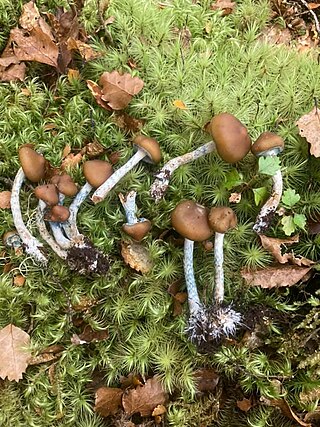
Psilocybe makarorae is a species of psilocybin mushroom in the family Hymenogastraceae. Officially described as new to science in 1995, it is known only from New Zealand, where it grows on rotting wood and twigs of southern beeches. The fruit body (mushroom) has a brownish cap with lighter coloured margins, measuring up to 3.5 cm (1.4 in) wide. The cap shape is either conical, bell-shaped, or flat depending on the age of the mushroom, and it features a prominent umbo. Although the whitish stem does not form a true ring, it retains remnants of the partial veil that covers and protects the gills of young fruit bodies. P. makarorae mushrooms can be distinguished from the similar North American species Psilocybe caerulipes by microscopic characteristics such as the presence of cystidia on the gill faces (pleurocystidia), and cheilocystidia with more elongated necks. Based on the bluing reaction to injury, P. makarorae is presumed to contain the psychedelic compounds psilocybin and psilocin.
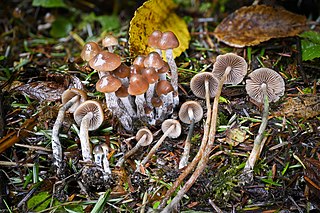
Psilocybe pelliculosa is a species of fungus in the family Hymenogastraceae. The fruit bodies, or mushrooms, have a conical brownish cap up to 2 cm in diameter atop a slender stem up to 8 cm long. It has a white partial veil that does not leave a ring on the stem. American mycologist Alexander H. Smith first described the species in 1937 as a member of the genus known today as Psathyrella; it was transferred to Psilocybe by Rolf Singer in 1958.

















